Vivid hues can be achieved with all natural colorants. In fact, you can create just about every color in the rainbow! For this Natural Rainbow Cold Process Soap, I used six colorants in the Natural Colorants Sampler Pack to create layers of red, orange, yellow, green, blue and purple. This soap is fragranced with a combination of lime and lemongrass essential oil for a scent that’s as bright as the layers.
For this project, I added the majority of the colorants directly to the soap batter. The one exception was annatto seed. I made an infusion with the seeds and used the infused oils to create the orange and yellow hues. To help the colors really pop, I recommend soaping at slightly higher temperatures (around 120-130° F) to help the soap go through a complete gel phase. I also recommend insulating the soap, and placing it on a heating pad if your room temperature is on the cooler side. Gel phase really helps natural colors pop! Click here to read more about gel phase, and when to insulate your soap.
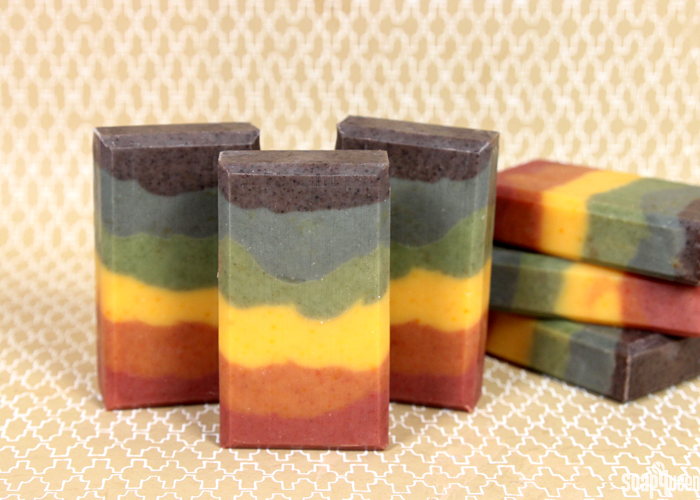
The drawback of natural colorants is they do tend to fade with time. These photos were taken about one week after cutting. The colors have faded slightly since then, but are still quite vivid. To help prevent the colors from fading, be sure to keep your bars out of direct sunlight. If you’ve never used natural colorants before, check out the Sunday Night Spotlight on natural colorants here. My new book, Pure Soapmaking, is also full of information on natural colorants, including how to infuse them and what they look like after they fade.
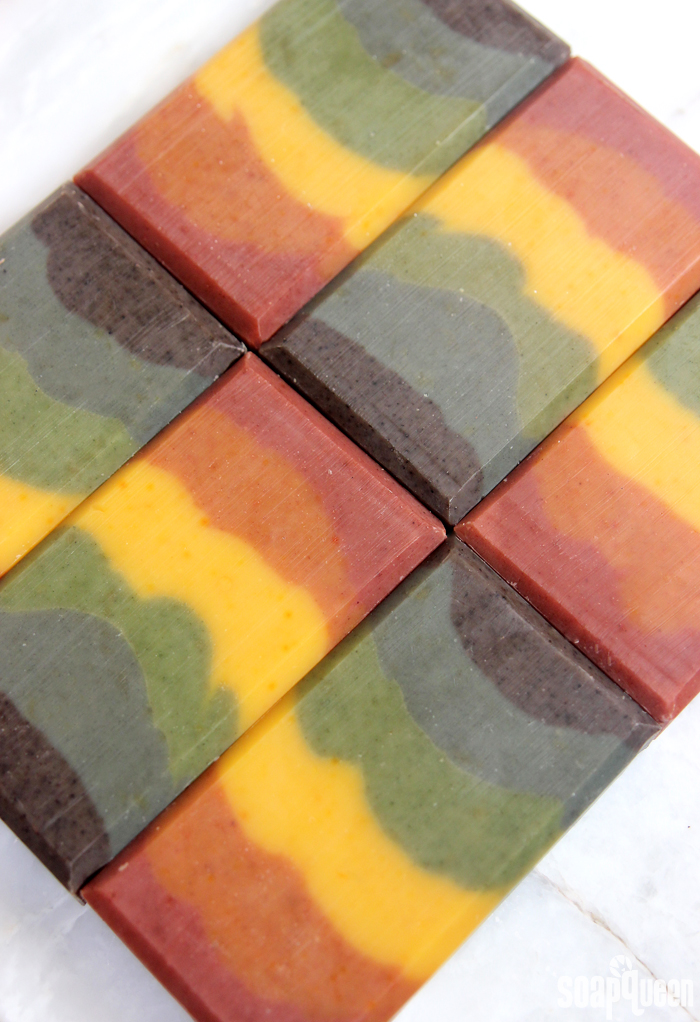
UPDATE 7/6/2016: Below is a photo of the soap about 5 months after unmolding. As you can see, some of the colors have faded slightly. Specifically, the green shade has faded the most. This soap was stored in a dry, cool and dark place. Most of the colors still look quite vivid!
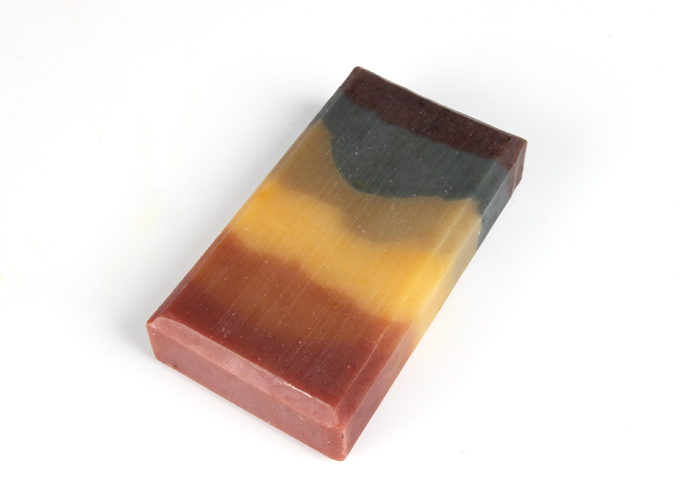
What You’ll Need:
Tall Narrow Wood Loaf Mold
44 oz. Basic Quick Mix
6.3 oz. Sodium Hydroxide Lye
14.5 oz. Distilled Water
2 oz. Lemongrass Essential Oil
1 oz. Lime Essential Oil
Natural Colorants Sampler Pack:
Madder Root Powder
Annatto Seeds
Indigo Powder
Spirulina Powder
Alkanet Root Powder
Note: The button below adds the Natural Colorants Sampler Pack, rather than the individual colorants needed. The pack includes all the colors necessary for this project, in addition to rose clay, nettle leaf, walnut shells and activated charcoal.

Click here to add everything you need for this project to your Bramble Berry shopping cart!
If you’ve never made Cold Process soap before, stop here! I highly recommend checking out our FREE four part SoapQueen.tv series on Cold Process Soapmaking, especially the episode on lye safety. And if you’d rather do some reading, Bramble Berry carries a wide range of books on the topic, including my newest book, Soap Crafting. You can also checkout the digital downloads for that instant gratification factor.
SAFETY FIRST: Suit up for safe handling practices! That means goggles, gloves and long sleeves. Make sure kids, pets, and other distractions and tripping hazards are out of the house or don’t have access to your soaping space. Always soap in a well-ventilated area.
COLOR PREP: Disperse 1 teaspoon of the alkanet root powder, spirulina powder and indigo powder into 1 tablespoon of lightweight liquid oil such as sunflower or sweet almond oil. Use a mini mixer to help get rid of any clumps. Then, disperse 2 teaspoons of madder root powder into 2 tablespoons lightweight liquid oil. In a separate heat safe container, add 1 teaspoon annatto seeds into 1 ounce liquid oil (I used sweet almond oil). Place the container in the microwave for about 20 seconds, or until the oil is warm to hot. Allow the mixture to thoroughly cool and the seeds to infuse the oil with a dark orange color. Strain out the seeds and set infused oil aside.
FRAGRANCE PREP: Measure 2 ounces of the lemongrass essential oil and 1 ounce lime essential oil in a glass, essential oil safe container. Set aside.
MOLD PREP: Line the Tall Narrow Wood Loaf Mold with freezer paper with the shiny side up. For tips on how to line the mold, click here.
ONE: Slowly and carefully add the lye to the water and gently stir until the lye has fully dissolved and the liquid is clear. Set aside to cool.
TWO: Fully melt the entire bag of Basic Quick Quick Mix until there is no cloudiness. Shake to mix and measure out 44 oz. Once the lye water and the oils have cooled to 130 degrees or below (and are ideally within 10 degrees of each other), add the lye water to the oils and stick blend until thin trace. If you’d like a harder bar of soap that releases faster from the mold, you can add sodium lactate to the cooled lye water. Use 1 teaspoon of sodium lactate per pound of oils in the recipe. For this recipe, you’d add about 2.5 teaspoons sodium lactate.
THREE: Once you’ve reached a thin trace, split the soap into six equal containers. Each container will contain about 300 mL.
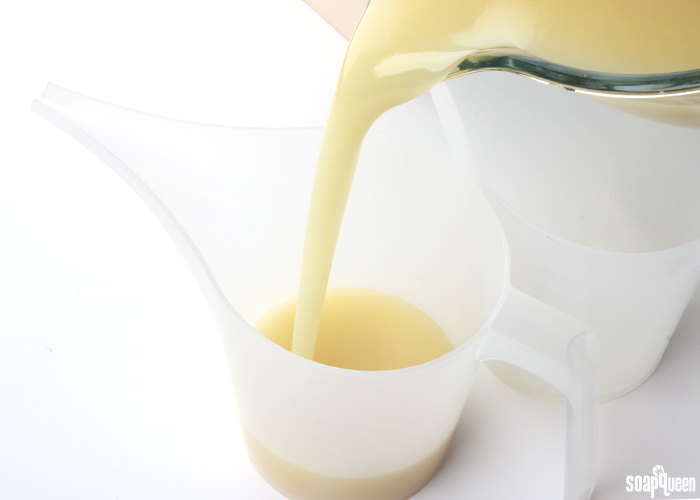
FOUR: To each container, add the amount of dispersed colorants listed below. Use a whisk to thoroughly mix in the colorants.
- Red: 1 Tbs. dispersed madder root powder
- Orange: 2 tsp. dispersed madder root powder + 3/4 tsp. annatto seed infused oil
- Yellow: 2 tsp. annatto seed infused oil
- Green: 2 tsp. dispersed spirulina powder
- Blue: 2 tsp. dispersed indigo powder
- Purple: 1.5 tsp. dispersed alkanet root powder
FIVE: Add the essential oil blend evenly between the six containers, it’s okay to eyeball it. Use a whisk to thoroughly mix in the oil. If the soap is still extremely thin, give each color a few bursts with the stick blender to thicken slightly. The soap should be thin enough to pour and spread, but thick enough that it will support layers on top. Then, pour all the red colored soap into the mold. Tap the mold firmly on the counter to help even out the soap.
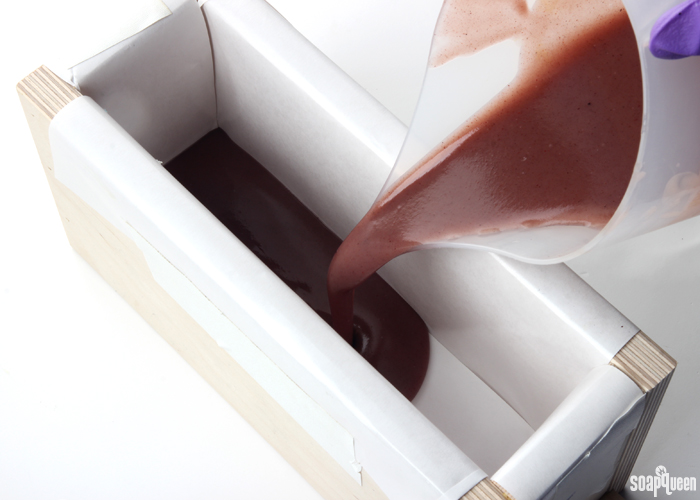
SIX: Carefully spoon the orange colored soap on top of the red, being careful to not let the orange soap break through the red layer below. Use a spoon to spread the orange soap evenly if necessary, then tap the mold firmly on the counter to help release any air bubbles. Continue layering the yellow, green, blue and purple soap into the mold, being careful to not break through to the layers below.
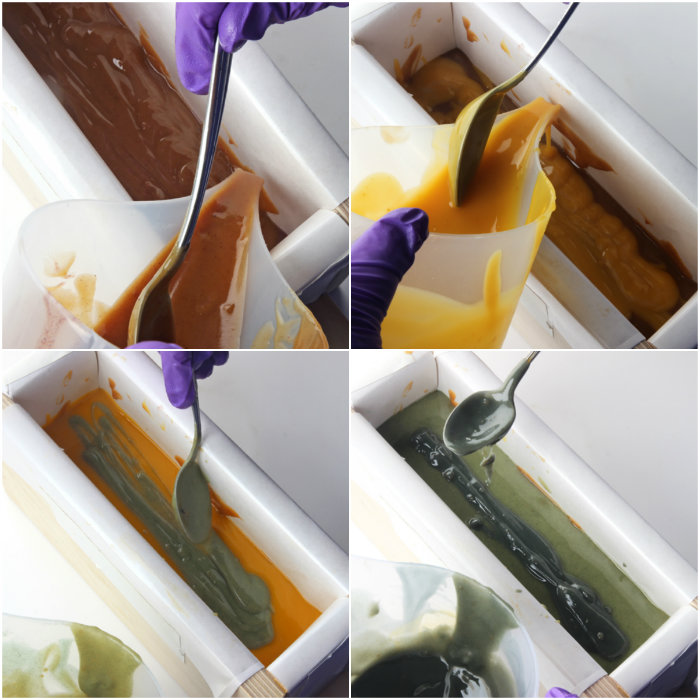
SEVEN: After you pour the purple soap on the very top, smooth the top with a spoon. Spritz the top with 99% isopropyl alcohol to prevent soda ash. Then, cover and insulate the soap for 24 hours. To help the colors pop, you want the soap to go through gel phase. If you’re soaping in a cold room, I would recommend placing the mold on a heating pad on medium heat for about an 30 minutes to help promote gel phase. After 2-3 days, remove from the mold and cut into bars. Allow to cure for 4-6 weeks and enjoy!
What is your favorite way to use natural colorants?
- Tall Narrow Wood Loaf Mold
- 44 oz. Basic Quick Mix
- 6.3 oz. Sodium Hydroxide Lye
- 14.5 oz. Distilled Water
- 2 oz. Lemongrass Essential Oil
- 1 oz. Lime Essential Oil
- Natural Colorants Sampler Pack:
- Madder Root Powder
- Annatto Seeds
- Indigo Powder
- Spirulina Powder
- Alkanet Root Powder
- Slowly and carefully add the lye to the water and gently stir until the lye has fully dissolved and the liquid is clear. Set aside to cool.
- Fully melt the entire bag of Basic Quick Quick Mix until there is no cloudiness. Shake to mix and measure out 44 oz. Once the lye water and the oils have cooled to 130 degrees or below (and are ideally within 10 degrees of each other), add the lye water to the oils and stick blend until thin trace. If you’d like a harder bar of soap that releases faster from the mold, you can add sodium lactate to the cooled lye water. Use 1 teaspoon of sodium lactate per pound of oils in the recipe. For this recipe, you’d add about 2.5 sodium lactate.
- Once you’ve reached a thin trace, split the soap into six equal containers. Each container will contain about 300 mL.
- To each container, add the amount of dispersed colorants listed below. Use a whisk to thoroughly mix in the colorants.
Red: 1 Tbs. dispersed madder root powder
Orange: 2 tsp. dispersed madder root powder + ¾ tsp. annatto seed infused oil
Yellow: 2 tsp. annatto seed infused oil
Green: 2 tsp. dispersed spirulina powder
Blue: 2 tsp. dispersed indigo powder
Purple: 1.5 tsp. dispersed alkanet root powder - Add the essential oil blend evenly between the six containers, it’s okay to eyeball it. Use a whisk to thoroughly mix in the oil. If the soap is still extremely thin, give each color a few bursts with the stick blender to thicken slightly. The soap should be thin enough to pour and spread, but thick enough that it will support layers on top. Then, pour all the red colored soap into the mold. Tap the mold firmly on the counter to help even out the soap.
- Carefully spoon the orange colored soap on top of the red, being careful to not let the orange soap break through the red layer below. Use a spoon to spread the orange soap evenly if necessary, then tap the mold firmly on the counter to help release any air bubbles. Continue layering the yellow, green, blue and purple soap into the mold, being careful to not break through to the layers below.
- After you pour the purple soap on the very top, smooth the top with a spoon. Spritz the top with 99% isopropyl alcohol to prevent soda ash. Then, cover and insulate the soap for 24 hours. To help the colors pop, you want the soap to go through gel phase. If you’re soaping in a cold room, I would recommend placing the mold on a heating pad on medium heat for about an 30 minutes to help promote gel phase. After 2-3 days, remove from the mold and cut into bars. Allow to cure for 4-6 weeks and enjoy!
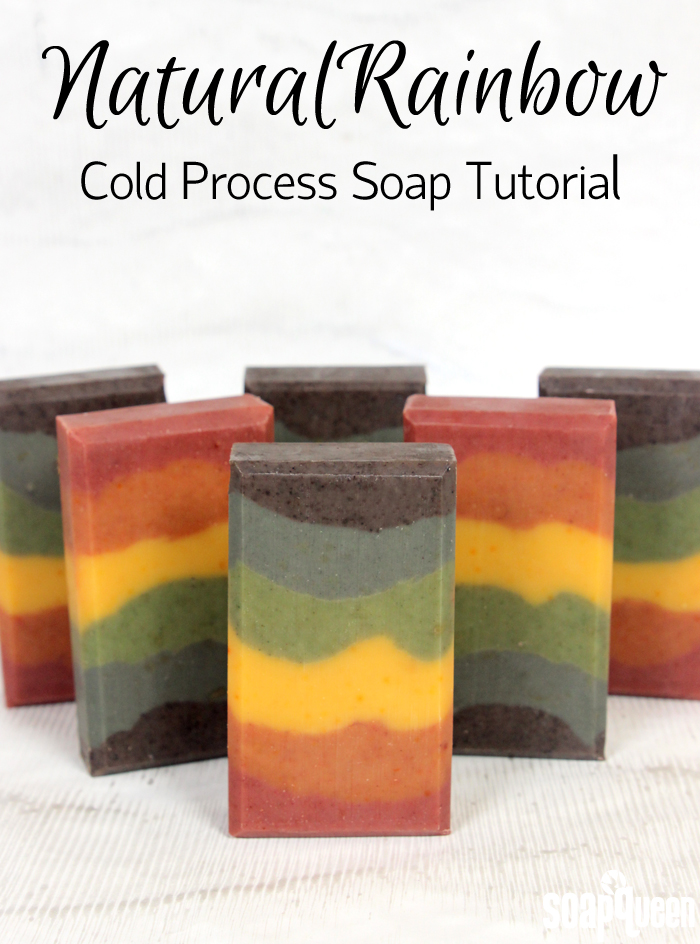
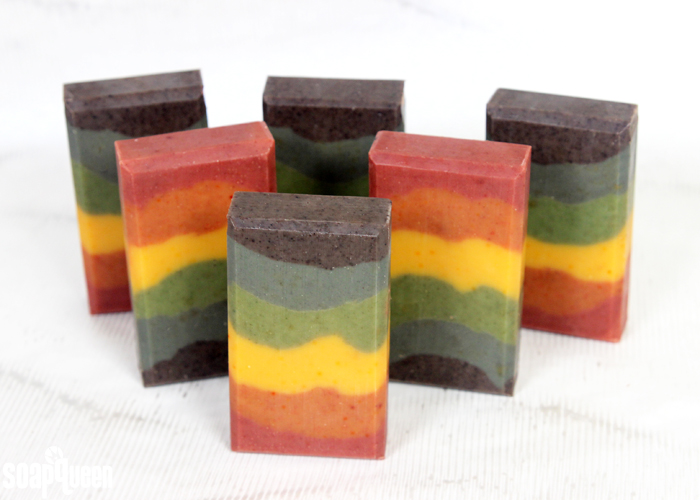
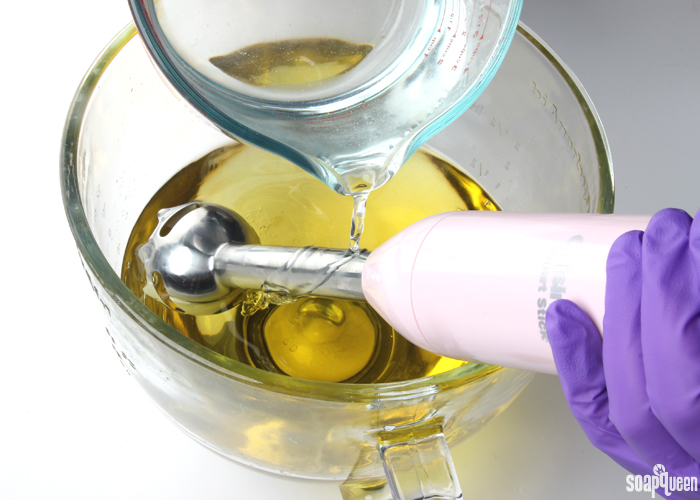
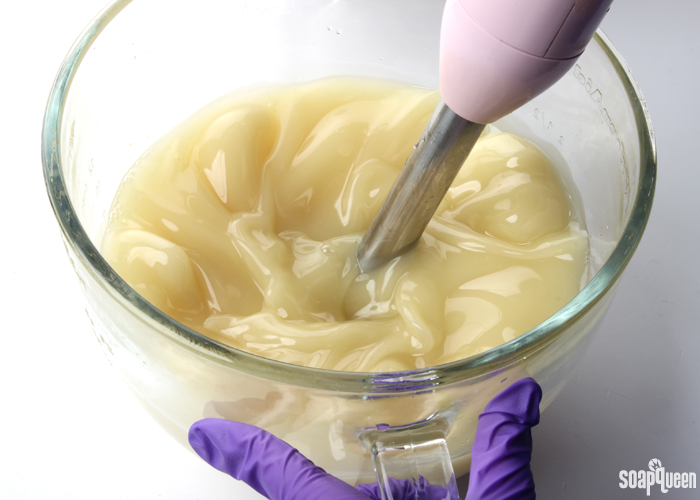
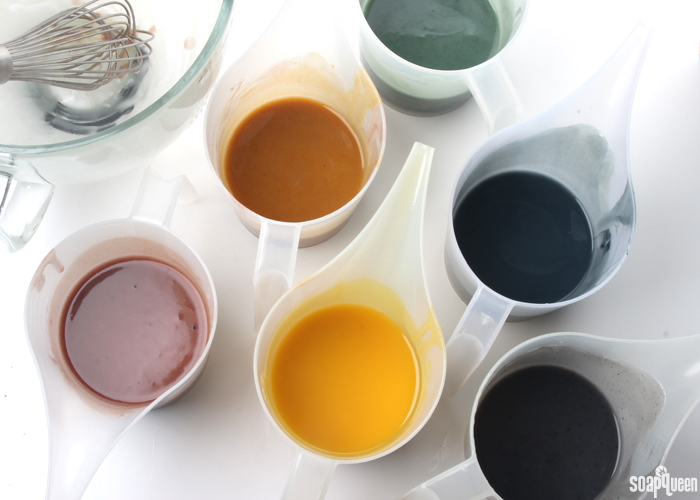
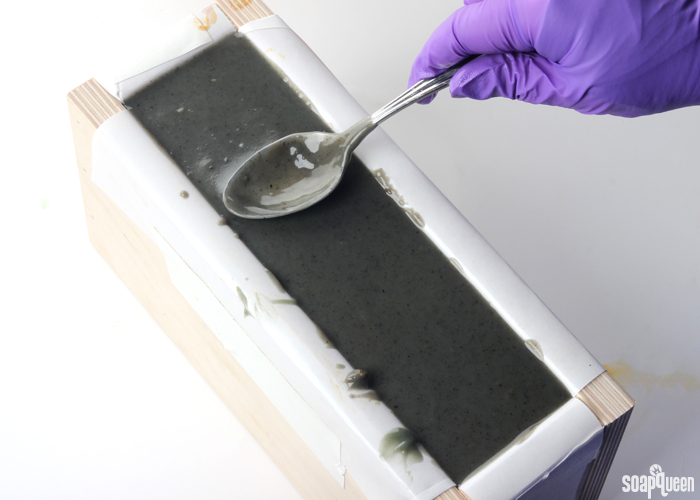
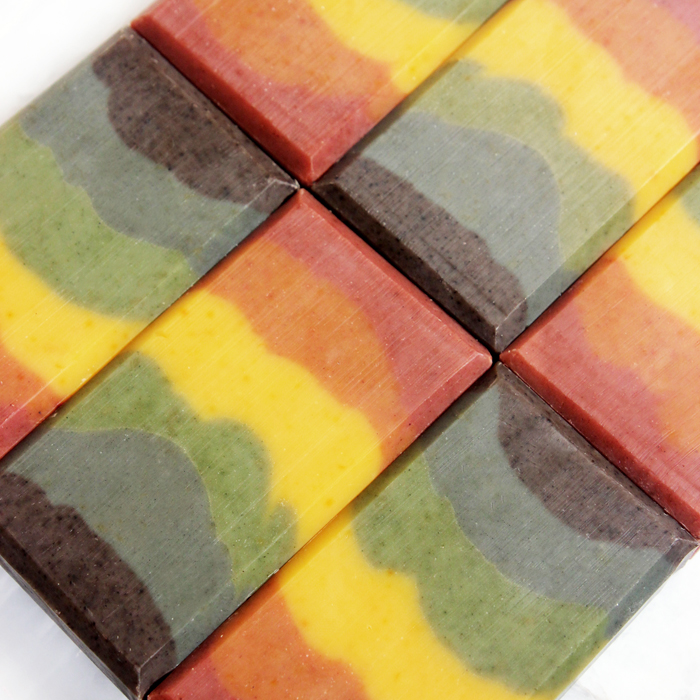



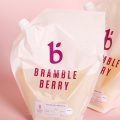
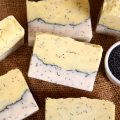
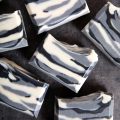
Can this be adapted for melt and pour base instead of cold process?
Yes, you can do a layered look with melt and pour. Learn more about creating layers here: https://www.soapqueen.com/bath-and-body-tutorials/5-tips-layering-melt-pour/
You’ll want to mix the colorants with 99% isopropyl alcohol instead of oil. This post has more on converting cold process recipes to melt and pour: https://www.soapqueen.com/bath-and-body-tutorials/tips-and-tricks/re-creating-cold-process-melt-pour-soap-designs/
Hi, thank you for your nice tutorial here.. I would like to know if the measurement of oils dispersed with the natural powder colorants were additives or discounted from the oils in the original recipe. Am a newbie and I still haven’t tried adding colors. Thank you.
The color mixed with oil is considered an additive, so it’s not discounted from the main oils. That makes it nice and easy to use. If you’re worried about adding too much oil, you can decrease the superfat by 1-2%.
Learn more about superfat here: http://www.soapqueen.com/bath-and-body-tutorials/cold-process-soap/superfatting-soap-an-explanation-2/
This says it makes 4 lbs of soap, but the mold it calls for only holds 3.5 lbs according to the description. Has the tall and narrow mold changed dimensions since this came out? I don’t want to spend a bunch of time mixing up all these wonderful colors only to find out the last color wont fit in the mold….
We have found you can add a little bit more soap if you want it to go all the way to the top of the mold. That gives you really nice tall bars. You may also lose some soap as you’re transferring to the other containers, so this recipe accounts for that. I would recommend making the full amount of this recipe and keeping a mold nearby in case you have any leftovers.
-Kelsey with Bramble Berry
I don’t have the tall mold called for in this recipe. Is there another mold I could use?
You can! You may need to resize the recipe based on how much your mold holds. Learn how to do that here: https://www.soapqueen.com/bath-and-body-tutorials/tips-and-tricks/how-to-resize-cold-process-soap-recipes/
That post was written when we had our old Lye Calculator, so it does look at bit different. However, it still works the same! 🙂
-Kelsey with Bramble Berry
How long before before CP can be removed from the mold?
It usually takes about 2-3 days! If the soap is still fairly soft after 3 days, let it sit another day or two and try again. 🙂
To help it unmold more quickly, you can add 1 teaspoon of sodium lactate per pound of oils to your cooled lye water! Read more about using sodium lactate here: http://www.soapqueen.com/bramble-berry-news/sunday-night-spotlight-sodium-lactate/
-Kelsey with Bramble Berry
Do you spritz the top of your loaf with the alcohol right away, or do you wait 15 min., where I’ve read before? Thanks.
We recommend spritzing the top of the loaf with alcohol right away. Then, you can spray every 15 minutes for the first hour if you like! That will create a barrier that protects the soap from soda ash. 🙂
Read more about preventing soda ash here: http://www.soapqueen.com/bath-and-body-tutorials/tips-and-tricks/explaining-and-preventing-soda-ash/
-Kelsey with Bramble Berry
Hi! I was wondering if you could provide the oil amounts for each oil contained in the quick mix used so I can make it with the oils I have instead of buying the quick mix? If so, is there another oil that can be used in place of the canola oil with similar results? Thanks!
Hi Laura!
Absolutely! You can find the percentage of oils in our Quick Mixes here: https://www.soapqueen.com/bath-and-body-tutorials/tips-and-tricks/sunday-night-spotlight-quick-mixes/
For canola oil, you can use olive oil or rice bran oil as a substitute! They have similar textures. Just make sure to run the recipe through the Lye Calculator after any substitutions. 🙂
This post has more information on how to substitute oils in cold process soap: http://www.soapqueen.com/bath-and-body-tutorials/tips-and-tricks/how-to-substitute-oil-in-cold-process-recipes/
-Kelsey with Bramble Berry
Lye Calculator: http://www.brambleberry.com/Pages/Lye-Calculator.aspx
Olive oil: https://www.brambleberry.com/Olive-Oil-Pure-P5246.aspx
Rice bran oil: https://www.brambleberry.com/Rice-Bran-Oil-P4971.aspx
Question-
I have used spirulina in my soap before without any issue. Sunday I made some and wanted to do a swirl so I colored just a portion of my oils with spirulina and for some reason that portion of my soap never set 🙁 I unmolded it Monday and the rest of the soap is perfect and hardened but the parts with spirulina are still mushy. I am afraid to cut it! What would cause this? Too much spirulina, maybe? Do you think it might just need to sit some more? I am so afraid I am going to have to scrap it! 🙁
Hi Madison!
I’m sorry about that! How much oil did you mix your spirulina with? If a lot of oil went into the batch, it may be a bit soft. It may also be that the soap is separating! How long did you stick blend it for? What temperatures were you soaping at? Let me know and I’ll help you troubleshoot. 🙂
-Kelsey with Bramble Berry
I don’t have the weight of the oils mixed with the spirulina but it was around half of a cup with a couple of tablespoons of spirulina. I used the 50oz silicone soap mold from Brambleberry to give you an idea of how much soap I was making. I stick blended until light trace at room temperature (for both portions of the soap, with no colorants and the portion with the spirulina). Thank you!
Thanks for the recipe details Madison! Was the half of cup of oil in addition to your base oils (extra oil)? Or was it oil pulled from the main batch?
-Kelsey with Bramble Berry
Hi, I also have a similar problem. I made my whole batch with powders. It’s still mushy and even after two weeks i’m not able to unmold it 🙁 How can I fix this batch?
How long did you stick blend your soap for, and how did you store it? Let me know and I can help you troubleshoot.
-Kelsey with Bramble Berry
Thanks for your answer, I hope I can fix it.
First I stick blended it to a very light trace and then divided the batch in 4 parts. After I mixed the powders I lost the trace, it became completely liquid. So I had to stick blend them quite a lot. After I got the trace back I poured them into plastic molds, covered them and stored them in the room temperature trying to keep them warm.
Do you notice any pools of oil or spots in the bars?
-Kelsey with Bramble Berry
No, it’s just mushy and doesn’t get hard. Do you think it would be okay to melt it again?
I’m thinking the trace may have broken a bit, which is why the bars are still mushy. We’ve had that happen on recipes with pretty thin trace. You may try rebatching them to help cook out any extra liquid and harden them: http://www.soapqueen.com/bath-and-body-tutorials/cold-process-soap/soap-queen-tv-presents-how-to-make-rebatch-soap-2/
For the next batch, stick blending a few more seconds will really help. That will ensure everything stays together and hardens in a few days.
Learn more about trace here: http://www.soapqueen.com/bath-and-body-tutorials/tips-and-tricks/trace/
-Kelsey with Bramble Berry
LOVE this! I knew something was lacking in the soap I want to make for my company’s Signature Soap, and this was it. Rainbows would be perfect for the next batch!
I wonder though if you could adapt this for hot processing…hot process each of the separate containers of soap and then quickly mix and layer the colors that way? Then you ensure that the colors are vibrant and the soap goes through gel without the uncertainty.
So glad you love the tutorial! We’re big fans of anything rainbow. 🙂
I think this recipe would work just fine using the hot process method! I would recommend making the soap in one container. Then, spoon out the soap into the containers, add the colors and layer that soap in the mold. You’ll need to work quickly! Once hot process soap is removed from a heat source it tends to heat up quickly. You can also divide the recipe weight by six (around 10.8 ounces in each container). That way you can pull out 1.8 ounces of soap from the Crock-Pot, mix the color and layer. The other soap would stay nice and warm in the pot and give you some time to work!
We did hot process layers in the Luck of the Irish Tutorial: https://www.soapqueen.com/bath-and-body-tutorials/cold-process-soap/luck-irish-hot-proces/
And this video talks more about how to make hot process soap: https://www.soapqueen.com/bath-and-body-tutorials/lavender-lemongrass-hot-process-soap-on-soap-queen-tv/
-Kelsey with Bramble Berry
I love this! It isn’t too bright, which is great for a change, and being 100% natural is even better! That natural color sampler pack looks fun to experiment with 🙂
Emmeline
So glad you love it Emmeline! I love the way the natural colorants look too. I hope you get a chance to experiment with Natural Colorant Sampler Pack. It has lots of great options. 🙂
-Kelsey with Bramble Berry